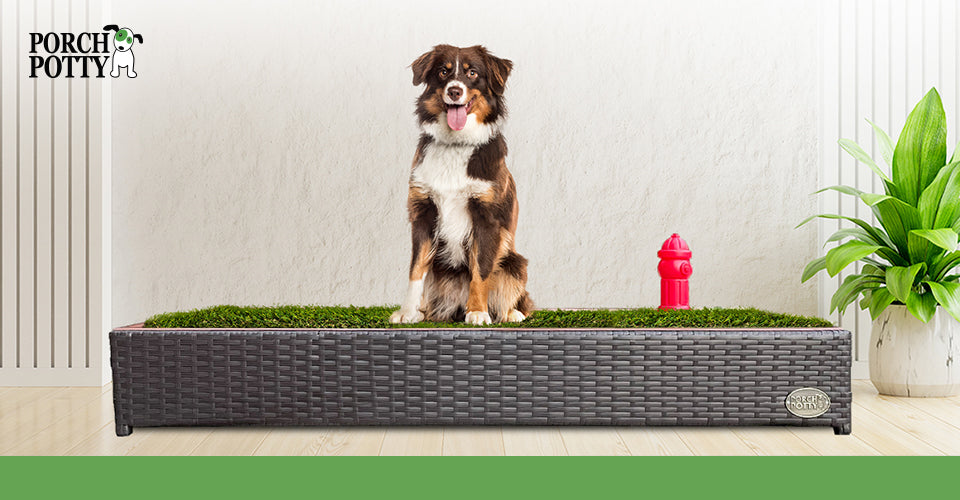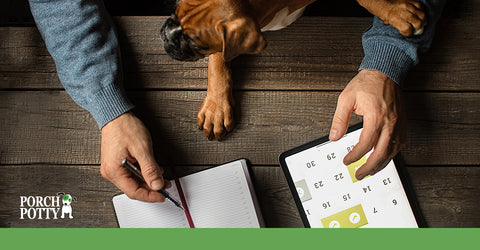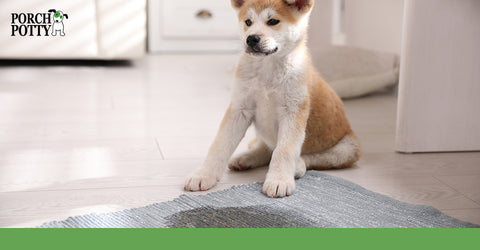
A black, tan, and white dog is sitting on a Porch Potty: an elevated box with green grass and a red rubber fire hydrant on the top of it.
Toilet training for dogs is one of the most critical aspects of pet ownership, but it can also be one of the most challenging. From accidents on the carpet to unpleasant odors in the house, many dog owners struggle with toilet training their furry friends.
However, with the proper techniques and patience, you can teach your dog to use the toilet like a pro. In this blog post, we'll discuss everything you need to know about dog training toilets, including how to toilet train a dog, toilet-training a puppy, and other valuable tips to make the process smoother.
First and foremost, it's essential to understand that toilet training a dog requires consistency and dedication. Whether you have a new puppy or an older dog, the process will take time and effort, but the results will be worth it.
We'll provide step-by-step instructions on toilet-training your dog, including crate training, routine setting, and positive reinforcement techniques. With our helpful tips and tricks, you can successfully toilet-train your dog and enjoy a cleaner, more pleasant home environment. So, let's get started and turn your pup into a potty pro!
Best Way To Start Toilet Training
Toilet training your dog can prove to be a daunting task. However, it is a crucial task to ensure a hygienic and healthy home environment. It doesn't matter if you have a new pup or an older dog; the process demands persistence, regularity, and commitment. Here are some of the helpful steps to start toilet training:
Step 1: Set Up a Routine
When toilet training your furry friend, establishing a routine is crucial. Dogs feel more comfortable with a consistent pattern, so you should plan a schedule for their meals, playtime, and bathroom breaks. Take your dog to the same spot whenever they need to relieve themselves and maintain a consistent time of day. Remember that puppies may need to go out more often, so take them outside every hour or so.
Step 2: Use Positive Reinforcement
Positive reinforcement is the way to go if you're looking for ways to train your dog to use the toilet. By praising your dog every time they go outside to do their business and giving them a treat as a reward, you can create a positive association that encourages them to keep using the designated outdoor spot. This approach can effectively achieve successful toilet training for your furry friend.
Step 3: Crate Training
If you're looking for a way to potty train your pup effectively, crate training could be the solution you're searching for. Dogs are naturally den animals, so they avoid dirtying their living space. While you're away or unable to keep an eye on your furry friend, you can confine them in a crate with some cozy bedding, water, and playthings. This technique can help prevent accidents indoors and train your dog to hold their urge to urinate until they're outside.
Step 4: Be Patient and Consistent
Teaching your furry friend toilet use requires considerable time and patience. It's common to encounter mishaps during the process, but avoiding scolding your dog is crucial. Instead, intervene while in an accident and lead them to the designated area outside. Consistency is critical when potty training so all household members adhere to the same regimen and employ identical cues.
To ensure successful potty training for your dog, it's crucial to establish a routine, employ positive reinforcement and crate training, and maintain patience and consistency. You can expect positive results by implementing these tips and techniques quickly.
Toilet Training Timeline and Tips

A man is on the floor, writing in an open day planner while looking at a calendar on his tablet. A tan boxer puppy with a black nose is laying down between his arms.
When training your new furry friend to avoid making a mess inside your home, you can take a few approaches, including housebreaking, house-training, or potty training. Regardless of the name, the ultimate goal is the same.
To make the process easier, it's recommended that you establish a timeline and stick to it. To reinforce this timeline, it's also essential to set clear rules for where your puppy should and should not eliminate. In addition, tools like dog crates and puppy pads can be beneficial for implementing your potty training plan.
Morning
Starting your day off on the right paw every morning with your furry friend is essential. When your alarm goes off, resist the urge to tend to other tasks and get your pup out of their crate and outside to relieve themselves. If you keep their crate close to your bedroom, you'll be able to hear if they need to go out during the night or before your alarm sounds.
For smaller pups, carrying them outside is best to prevent accidents on the way to the door. Be sure to consistently take your puppy to the same designated area to potty and keep them on a leash during training, even in a fenced yard. This will allow you to monitor their progress and react quickly to any behavior that needs correcting.
After Every Meal
If you're a new puppy owner, it's crucial to establish a routine for their meals and potty breaks. After your furry friend has done their business in the morning, it's time for breakfast. Keeping a consistent meal schedule will help regulate their elimination, making it easier to anticipate when it's time for potty breaks.
After a meal, waiting between 5 and 30 minutes before taking your puppy outside is best. Younger puppies need to go out sooner than older ones, as they have less control over their bladders. Most puppies eat three to four times a day while growing, and it's typical for them to poop after a meal. Paying attention to this follow-up period is crucial.
Remember, water breaks! Taking your puppy out to potty after a drink is essential, like meals. Establishing a routine for your puppy's meals and potty breaks will lead to a happy and healthy pup.
After Naps and Playtime
Young puppies need to relieve themselves at various times, not just in the morning and after meals. After naps and playtime are also expected times for potty breaks. When your puppy wakes up from a nap, take them outside immediately. Watch for signs your pup needs to go during playtime, such as sniffing, wandering, or being overexcited. If you see any signs, take your puppy outside to potty without delay.
Common Mistakes To Avoid When Toilet Training A Dog

A white and tan Shiba Inu puppy is sitting on light beige tile floor in from of a grayish-blue area rug that has a wet spot on it.
If you need help with puppy potty training, mistakes may still occur even if you follow all the proper steps. These errors could result from poor communication, outdated advice, or other factors. To assist you in avoiding these pitfalls, we have compiled a list of common mistakes pet owners make when crate-training their puppies. We provide helpful information to help your furry friend adjust to their new surroundings.
1. Inconsistent Training
When toilet training your dog, inconsistent training is a common mistake many dog owners make. Maintaining a consistent routine is crucial for successful training. This involves having a regular schedule for meals, playtime, and toilet breaks. Dogs respond well to patterns, so it's essential to be consistent in your training approach. It's also important to ensure that everyone in the household follows the same routine and uses the same commands.
2. Punishing Your Dog
It's important to avoid punishing your furry friend for accidents. Dogs don't comprehend punishment, and it can result in fear, anxiety, and behavioral problems. Instead, opt for positive reinforcement like praising and offering treats when your dog relieves itself outside. This will motivate them to repeat the desired behavior going forward.
3. Not Supervising Your Dog.
Ensuring that you supervise your furry friend during potty training is paramount. Neglecting to do so can lead to accidents and the perpetuation of undesirable habits. Constant monitoring and regular outdoor breaks, particularly after meals, play sessions, and nap time, are highly recommended. If you cannot supervise your dog directly, crate training may be a viable alternative.
4. Not Cleaning Up Accidents Properly.
Dogs possess a strong sense of smell, and failing to clean up their mess correctly may result in repeatedly using the same spot. To avoid this, it's recommended to use an enzymatic cleaner to eradicate traces of urine or feces thoroughly. This will remove the scent and discourage your furry friend from returning to the same place.
How long does it take to toilet-train a dog?

A woman in a light blue shirt lays down on her stomach outside in the grass while holding on to her bulldog's leash. The tan bulldog is standing in front of her.
When you own a dog, toilet training becomes crucial to pet ownership. Your dog's age is the first factor that can impact the duration of toilet training. Training a puppy can take a few weeks to several months, depending on its breed and personality. Smaller breeds have smaller bladders and need frequent potty breaks, while larger breeds can hold them longer. Adult dogs can also be trained, but the process may take a little longer, mainly if they are used to relieve themselves indoors.
Considering these factors, you can better understand toilet training your dog and help them develop good habits.
Can an adult dog be toilet trained?
The answer to whether an adult dog can be toilet trained is affirmative. However, it's worth noting that the process may take longer than it would with a puppy. Adult dogs are often more accustomed to their ways and may have already formed habits that require breaking before establishing new ones. Additionally, if your dog is older, they may have some underlying medical conditions that make it challenging to control their bladder or bowel movements. As such, it is crucial to seek advice from a vet before taking on any toilet training program.
Conclusion
Training your pet to use the toilet can be complex, but it is achievable with the correct approach and consistency. Establishing a routine, using positive reinforcement techniques, and crate training is essential if necessary. Patience and consistency are critical factors in successfully training your dog. It is important to note that accidents are normal during training, but with the tips and techniques provided in this blog post, your pet will become a pro in no time. Begin the process today and enjoy a hygienic and comfortable living environment with your furry friend.
For more information on potty training, check out these articles:
A Schedule For Potty Training Your Puppy



